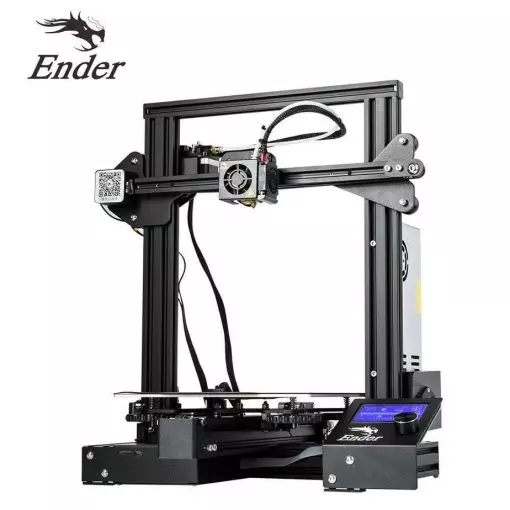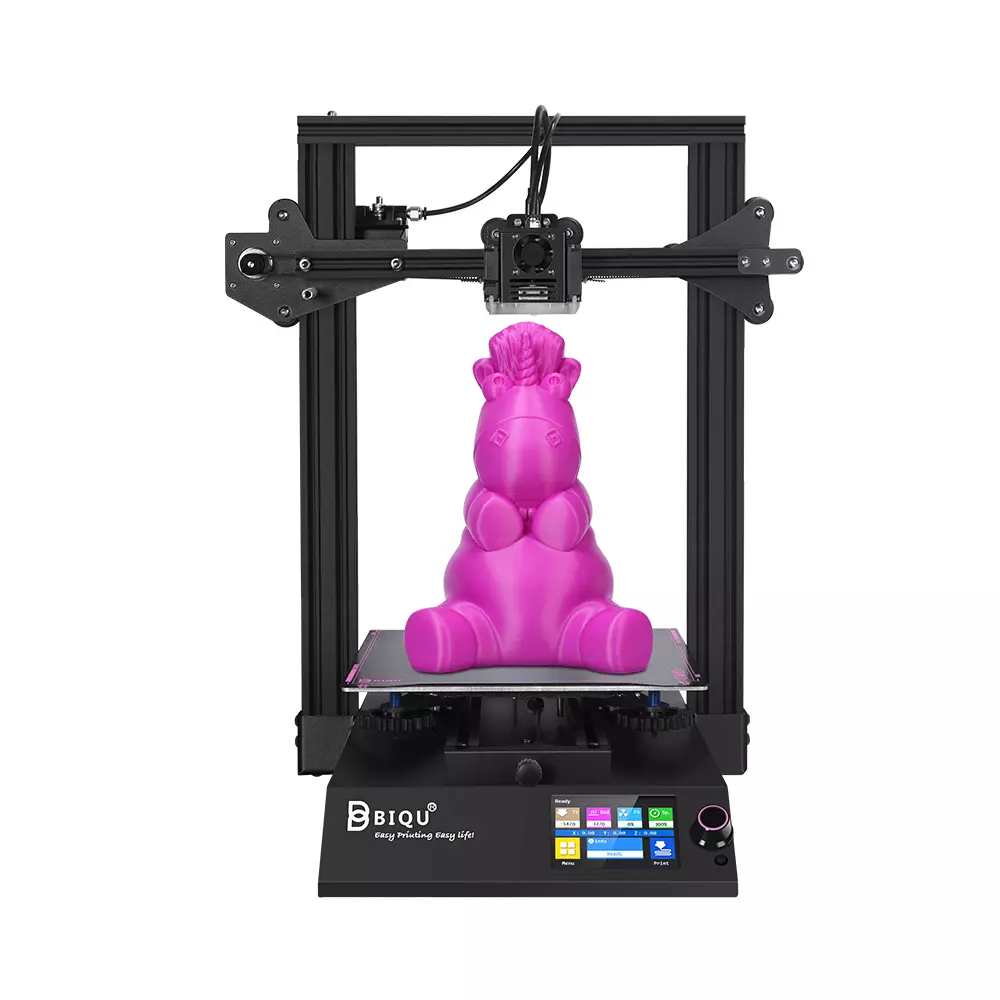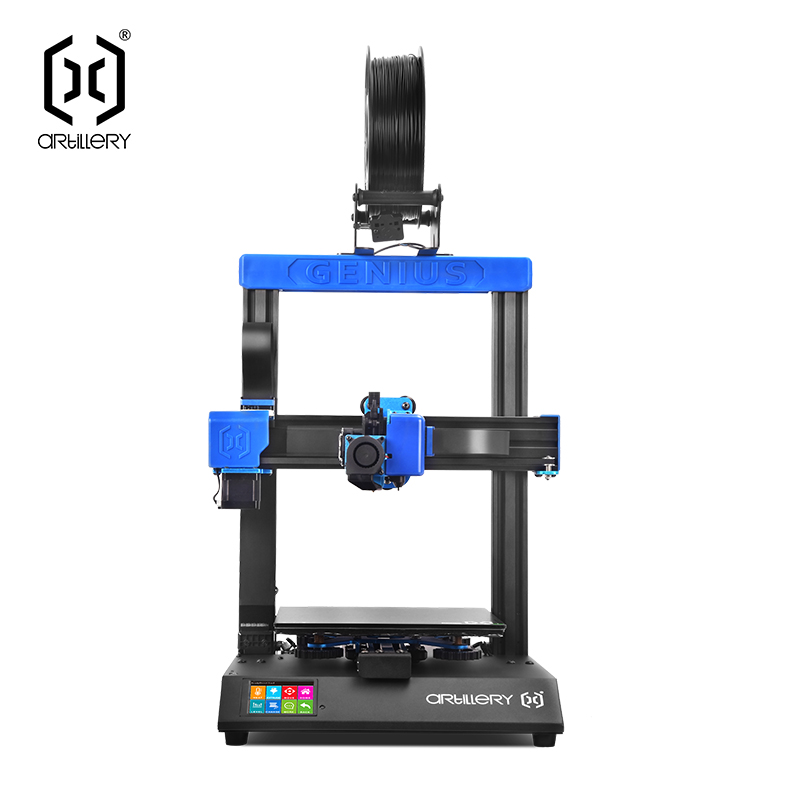Compare Ender 3 vs BIQU B1 vs Genius Pro
Comparison between the best 3D printers
Choose the best 3D printer at the best price. The cheapest 3D printers are here.
Buy a 3D printer here with 3D Fila.
 |
 |
 |
|
| Model | Ender 3[BUY Ender 3] |
BIQU B1 |
Genius Pro[BUY Genius Pro] |
| Printing Material | Filament | Filament | Filament |
| Estimated price | $210,00 | $269,00 | $309,00 |
| Fabricante | Creality 3D | BigTreeTech | Artillery |
| Release Year | 2018 | 2020 | 2022 |
| Print Volume [mm] | 220x220x250 | 235x235x270 | 220x220x250 |
| Printer Size [mm] | 440x440x465 | 412x402x492 | 430x390x590 |
| Weight [kg] | 6,62 | 8,00 | 9,6 |
| Power Loss Recovery | NO | YES | YES |
| Enclosed printer | NO | NO | NO |
| Bed Leveling | Manual | Manual | Automatic |
| Filament End Sensor | NO | YES | YES |
| Bed type | Heated | Heated | Heated |
| Power supply system | Bowden | Bowden | Direct Drive |
| Standard nozzle | 0,4 | 0,4 | 0,4 |
| Maximum Nozzle Temperature [°C] | 255 | 250 | 240 |
| Maximum Bed Temperature [°C] | 110 | 100 | 120 |
| Maximum printing speed [mm/s] | 180 | 100 | 150 |
| Filament holder | YES | YES | YES |
| Camera for supervision | NO | NO | NO |
| Recommended filaments | PLA, TPU, ABS, PETG | PLA, TPU, ABS, PETG | PLA, PETG, Tritan, Flex, ABS |
| Recommended slicers | Cura, Simplify, Slic3r | Cura, Simplify, Slic3r | Cura, Simplify, Slic3r, IdeaMaker |
| Maximum Resolution [mm] | 0,1 | 0,1 | 0,1 |
| Processor | 8 bits | 32 Bits BTT SKR V 1.4 | Ruby 32bit |
| Display | Mono | Touchscreen TFT 3,5'' | Touchscreen TFT 3,5'' |
| Power Supply | 24V / 270W | 24V / 360W | |
| Connectivity | SD / USB | SD / USB | SD / USB |
| Operating systems | Windows, Mac, Linux | Windows, Mac, Linux | Windows, Mac, Linux |
| Date of registration in the system | 2021-04-13 | 2021-04-14 | 2022-11-07 |
| Release date | 2018 | 2020 | 2022 |
| Extra features | The Ender 3 V1 is a DIY assembly 3D printer, a sales leader since 2017, standing out for its cost-benefit. With a wide printing capacity, it has a CNC machined structure for precision and stability. It offers high-precision prints with low noise, thanks to its innovative V-profile and pulleys. It has a self-adhesive magnetic platform for easy removal of models and excellent adhesion. The Ender 3 heats up quickly, reaching 100°C in 5 minutes, ideal for agile prints. It includes protection against power failures, allowing you to resume printing after interruptions, saving time and material. | The BIQU B1 is an advanced 3D printer with a silent 32-bit BTT SKR V1.4 motherboard and ARM Cortex-M3 CPU, offering DIY interfaces (I2C, SPI, WiFi) and dual Z-axis. Its dual BTT B1 TFT35 V3.0 operating system allows real-time monitoring and multiple printing modes, including G-code visualization effects. It stands out for its BIQU SSS (Super Spring Steel), ensuring easy model adhesion and simplified removal, with the possibility of using it on both sides. It includes a filament sensor, automatically pausing printing in case of filament breakage. The multicolored RGB lights integrated into the hotend allow you to view the printing status even at night. Additional notes include the need for a BIQU-specific Type-C cable and extra interfaces for smart filament sensor and BL Touch. | The Artillery Genius Pro is a standout 3D printer with a fast-heating AC tempered glass print bed and a sleek design with a black aluminum base and blue accents. It features a Titan-style direct extruder and a 32-bit Ruby mainboard. Despite its advanced feature set, it struggles to maintain print quality, requiring frequent adjustments and calibrations, and its glued glass bed makes cleaning and replacement difficult. |
| Support for multiple colors and materials (AMS and CFS) | NO | NO | NO |
Notes * |
|||
| Cost-benefit | 6 / 10 | 7 / 10 | 7 / 10 |
| Hardware | 0.5 / 10 | 2 / 10 | 2.8 / 10 |
| Screen | . | . | . |
| Print volume | 3 / 10 | 3 / 10 | 3 / 10 |
| Performance | 1 / 10 | 1 / 10 | 1 / 10 |
| [BUY Ender 3] | [BUY Genius Pro] |
Conclusion |
| In comparing the three 3D printers—Ender 3, BIQU B1, and Genius Pro—several key factors highlight their strengths and weaknesses, ultimately guiding a recommendation based on user preferences and budget considerations. The **Ender 3** stands out as the most cost-effective option, offering reliable performance, a decent build volume, and a well-established reputation in the DIY community. While it lacks some advanced features like power loss recovery and filament sensors, its simplicity and ease of use make it ideal for beginners or those seeking a basic yet effective 3D printing experience. The **BIQU B1** introduces several enhancements over the Ender 3, including a silent motherboard and automatic filament sensing. This model provides a good balance of features and price, aimed at users who value additional functionality without breaking the bank. The dual Z-axis and real-time monitoring options enhance its versatility, making it suitable for users who want a more involved printing experience. The **Genius Pro**, while the most expensive of the three, offers direct drive extrusion and a spacious print bed, catering to those who expect high-quality prints and are willing to invest in more sophisticated technology. However, users may find that its performance can necessitate frequent calibrations and adjustments, detracting from its overall reliability. In conclusion, the **Ender 3** is the best choice for budget-conscious beginners, while the **BIQU B1** is a strong middle-ground option for those looking for extra features. The **Genius Pro** is suited for more experienced users willing to navigate its quirks for potentially superior results. Ultimately, the decision should align with individual printing needs, experience level, and budget constraints. |

